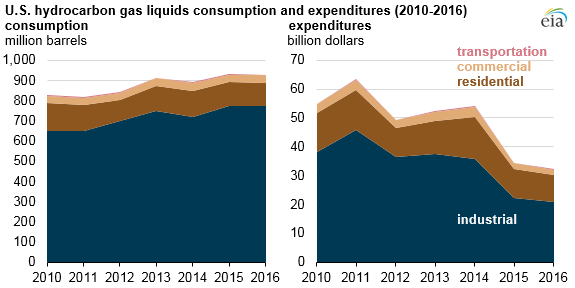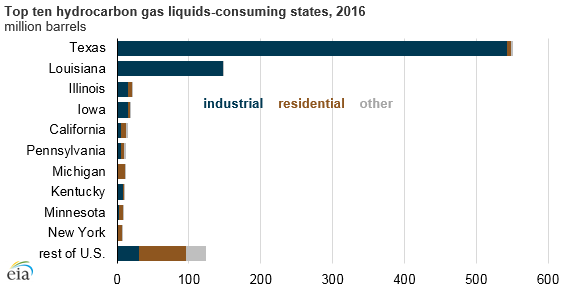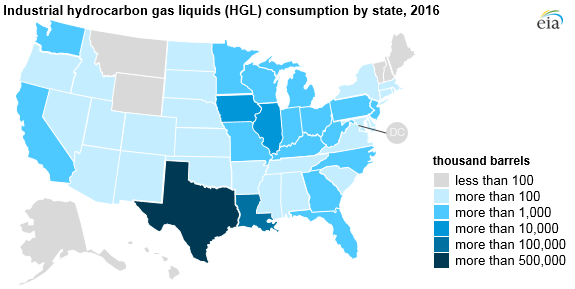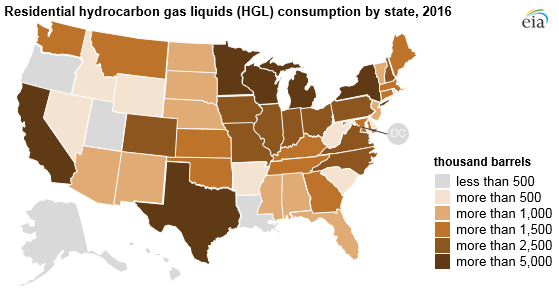
The Texas and Louisiana industrial sectors dominate HGL consumption, expenditures, and price formation in the United States. The two states combined to account for about 75% of total U.S. HGL consumption and 58% of total U.S. HGL expenditures in 2016, almost all of which was in the industrial sector. The HGL pricing hub in Mont Belvieu, Texas, heavily influences the prices of HGL products across the nation.
EIA’s State Energy Data System (SEDS) recently published a new categorization of petroleum products with annual state-level estimates of HGL consumption, prices, and expenditures by end-use sector for 1960 through 2016. HGLs include natural gas liquids (ethane, propane, normal butane, isobutane, and natural gasoline) and refinery olefins (ethylene, propylene, normal butylene, and isobutylene). Almost all HGLs not used as refinery and blender inputs are consumed exclusively in the industrial sector, with the exception of propane, which is consumed in all sectors.
The industrial sector is the largest consumer of HGLs in the United States, accounting for about 83% of total U.S. HGL consumption in 2016. Industrial consumption of HGLs is primarily for feedstocks in the production of intermediate organic chemicals such as ethylene and propylene, which are used to make plastics and resins.
Industrial sector HGL consumption increased by 125 million barrels, or about 19%, between 2010 and 2016. Over the same time, industrial HGL expenditures decreased by more than $17 billion (45%), as the average U.S. price of industrial HGLs decreased from $16.64 per million British thermal units (Btu) in 2010 to $7.79 per million Btu in 2016.
The residential sector, the second-largest HGL-consuming sector, is the only sector to decrease consumption between 2010 and 2016. Residential sector HGL consumption, primarily consumer-grade propane for space heating, water heating, and cooking, was 112 million barrels in 2016, a 19% decrease from 2010.
Lower residential consumption of propane was attributed to warmer winter temperatures in 2016 relative to 2010 and to the decline in total households reporting propane as a primary heating fuel. Residential HGL expenditures decreased by about 32% as the average U.S. price of residential HGL decreased from $25.68 per million Btu in 2010 to $21.59 per million Btu in 2016.
The commercial sector and the transportation sector consume relatively small amounts of HGLs, accounting for 4% and 1% of total HGL consumption, respectively, in 2016. The commercial sector consumes propane as a heating fuel, and the transportation sector uses propane for fueling alternative-fueled vehicles, such as propane-fueled police cars and school buses.


The largest residential HGL-consuming state is Michigan, with about 8% of total U.S. residential consumption in 2016. California, Wisconsin, New York, and Minnesota are the next largest residential HGL consumers, each with about 5% of total U.S. residential HGL consumption. Louisiana, despite being one of the largest HGL-consuming states, consumes relatively little HGL in the residential sector, because most home heating is fueled by electricity and the state has modest heating demand.


Follow us on social media: